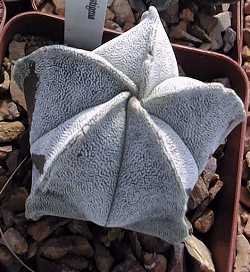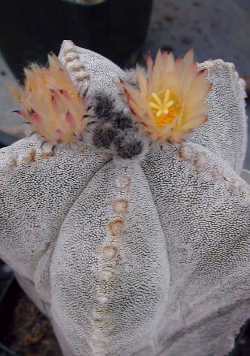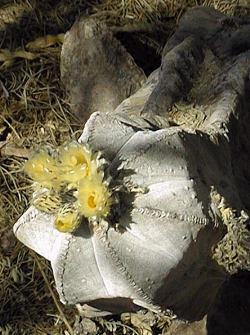Bishop's Miter, Bishop's Cap
Scientific Name: Astrophytum myriostigma Lem.
Synonym: Astrophytum coahuilense, Astrophytum columnare, Astrophytum myriostigma var. columnaris , Astrophytum myriostigma var. multicostatus , Astrophytum myriostigma var. viescaensis , Astrophytum myriostigma var. potosinum , Astrophytum nuda, Astrophytum prismaticum, Astrophytum tulense, Echinocactus myriostigma
Family: Cactaceae
USDA: 9b-10
Frost Tolerance: Hardy to 20°F (-6°C) for short periods
Sun Exposure: Full sun to light shade
Origin: Highlands of central and northern Mexico
Growth Habits: Columnar cactus, up to 2 feet long (60 cm) by 8 inches in diameter (20 cm); 4 to 6 ribs (usually 5); no spines;
Watering Needs: Moderate water in summer. Needs dry winter rest.
Propagation: Seeds that germinate rapidly. Some cultivars are grafted. They take up to 6 years to bloom.

The Bishop's Miter is an attractive cactus, relatively cold resistant. The stems can be over 3 feet long and 8 inches in diameter (1.2 m by 20 cm). The name 'Astrophytum comes from the Greek for "star plant". The number of ribs vary from 4 to 8.

Blooming Habits:
The glossy yellow, sweet scented flowers appear continuously during the summer. They are followed by a reddish fruit, 1 inch in diameter (2.5 cm). The plants known as A. coahuilense have a reddish orange throat.
Culture:
The Astrophytum myriostigma grows much faster with fertilizer in spring and summer, and regular water throughout the summer. Keep dry as soon as the temperature starts dropping in October. Although it is one of the easier Astrophytum to grow, they tend to rot at that time of the year, if kept wet.
Its color tends to richer and darker when grown in light shade. Mealy bugs and root mealy bugs can be a problem.
Desert-Tropicals is dedicated to provide gardening advice, gardening ideas, and information about flower of all kind for landscape and collections.We try to check carefully the identification of the plants on the illustrations as well as the other information from the page, but occasionally errors do occur. if you notice anything that needs to be changed please contact us.Thanks.
© 1998-2020 Philippe Faucon, All Rights Reserved.
